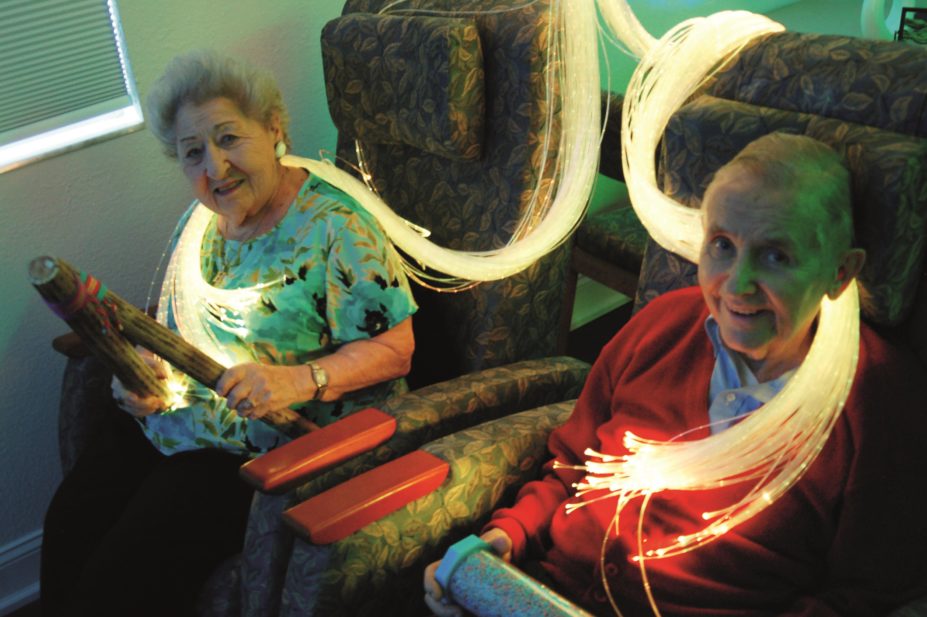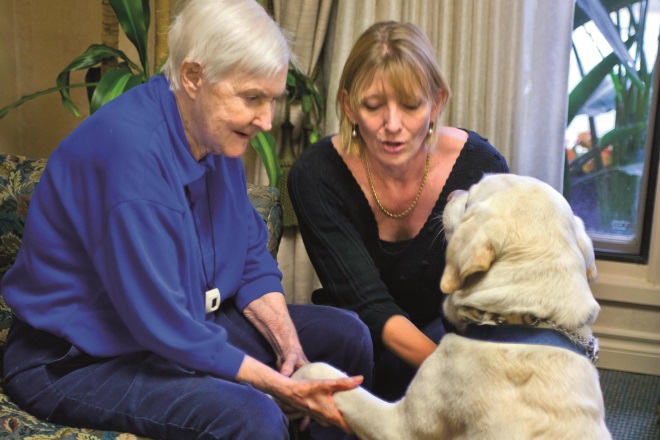
Courtesy of Kobernick-Anchin-Benderson
Dementia is an umbrella term for a range of progressive conditions where consciousness is not impaired but there is a disturbance of multiple higher functions. Memory, thinking, orientation, comprehension, calculation, learning, language capability and judgement can all be affected. This can also manifest in other areas, such as emotional control, social behaviour and motivation[1]
.
In 2014, almost 850,000 people in the UK were living with dementia, which is approximately 1% of the total population. This number is set to grow and is predicted to exceed 1 million by 2025 and 2 million by 2051[2]
. The government has identified dementia as a priority and in 2009 published a national strategy to guide dementia care and treatment[3]
.
Two-thirds of people living with dementia do so in the community while the rest tend to reside in care homes. Care home residents with dementia make up around 70% of the care home population[4]
. In addition, around a quarter of hospital beds are usually occupied by people over the age of 65 years with a diagnosis of dementia[5]
. It is therefore important that people working in or providing services to these areas are aware of ways to help and communicate with those living with dementia.
Treatments and interventions
Medicines licensed for use in treating dementia include the cholinesterase inhibitors galantamine, rivastigmine and donepezil and the NMDA antagonist memantine[6],[7],[8],[9]
. These medicines do not stop the progression of dementia but, in some cases, can slow it down. A technology appraisal from the National Institute for Health and Care Excellence (NICE), England’s health technology assessment body, evaluated the use of these agents in 2011 (NICE TA 217)[10]
and their place in therapy is established.
NICE also examined treatments in its clinical guideline – ‘Dementia: Supporting people with dementia and their carers in health and social care’[11]
. This guidance examined the evidence behind non-pharmacological therapies. These therapies fall into two main areas — the first considers interventions for cognitive symptoms and maintaining function, while the second looks at interventions for non-cognitive symptoms and challenging behaviour (or ‘behaviour that challenges’).
Cognitive symptoms and maintaining function
The only non-pharmacological therapy endorsed by NICE for improving cognitive symptoms is group cognitive stimulation therapy (CST).
Group CST generally follows a programme of 14 or more sessions[12],[13]
and the group will usually meet twice a week, although this may vary. CST uses reminiscence, stimulation and reality orientation and focuses on opinion and discussion. Reminiscence involves discussing past activities and events in a group while reality orientation helps the person understand the present using visual prompts, such as flip charts showing the name and purpose of the group. CST utilises implicit teaching styles, meaning that participants absorb information in an incidental way and are not aware that they are learning.
Group therapy can be provided by trained professionals and participants benefit from this shared experience and social aspects of being in a group. In addition, the sessions provide an opportunity for patients to enhance and maintain their skills related to daily living activities. For example, sessions are based around themes, such as managing money, recognising faces or word association.
Guiding principles for sessions include promoting discussion of opinions, rather than facts, while stimulating language, new thoughts and associations. There is also a maintenance programme that can be continued after the initial course, which is designed to build on the skills developed. Patients with their carers may produce aids, such as thinking cards, which promote the use of calendars, visual prompts and helpful tips to enhance and prolong the benefits already gained.
A trial in London involving 201 participants demonstrated that CST mainly improved language, with some improvements noted in ability to follow instructions[12]
. There were no improvements to memory and new learning[12]
. Improving communication and promoting conversation are likely to have general benefits in maintaining quality of life and activities of daily living[12],[13]
.
Since the publication of the NICE clinical guidelines, individual CST has been developed, which can be used and practised by carers[14]
. This can be useful where the patient may have difficulty participating in the group programme or in areas where group sessions are not available. Similar to group therapy, this works most effectively in the early-to-mid stages of dementia[14]
.
Individual CST may be most useful for carers of people with dementia. In a trial of 356 caregivers, individual CST appeared to improve relationships between people with dementia and their carers and also improved health-related quality of life for the carers[14]
. The more sessions a carer delivered, the fewer depressive symptoms the carer was likely to report. There was no significant effect on cognition, depressive symptoms or quality of life for the person with dementia[14]
.
A 2012 Cochrane review concluded that there was consistent evidence from 15 trials on a mixture of group and individual CST that cognitive stimulation benefits people with mild and moderate dementia over and above any medication effects[15]
.
Challenging behaviour
Interventions endorsed by NICE associated for use in challenging behaviour, such as agitation, include aromatherapy, massage, animal assisted therapy, therapeutic use of music and/or dancing and multisensory stimulation.
Aromatherapy
A Cochrane review in 2014 provided an update of the evidence for aromatherapy and found that lavender was beneficial in some studies for promoting sleep[16]
. Sleep disturbance may be present in dementia and improvements included an increase in total sleep time and reduced requirements for hypnotic medication. However, in several studies the effect of the aromatherapy was not long lasting and in some circumstances actually led to increased agitation[16],[17],[18],[19]
.
The main effects of aromatherapy on people living with dementia appeared to be in the domains of agitation, motor activity and sleep, with no effect on cognition[16]
. Studies where aromatherapy oil was introduced via massage (‘aroma-acupressure’) rather than via a diffuser appeared to have a more successful outcome[16]
and a trial published in 2015 demonstrated that aroma-acupressure had more of an effect on calming agitation than aromatherapy alone. Both were more effective than no intervention or ‘care as usual’[20]
. In this study, 186 participants were given the intervention for four weeks, with assessments at baseline, regularly at weekly intervals during the intervention and at three weeks post-intervention[20]
.
Massage
Massage as an intervention was reviewed in 2008 by Cochrane, which concluded that there was insufficient evidence regarding the efficacy of touch or massage interventions[21]
. However, there was some evidence to support the efficacy of two sub-types of touch interventions: the application of hand massage for immediate and short-term reduction of agitated behaviour and the use of touch in addition to verbal encouragement to eat.
More recent studies have been conducted on various types of massage, including foot, hand and slow stroke back massage[22],[23],[24],[25],[26]
. Gentle massage is found to calm older people and lower blood pressure[27]
although results on improving sleep are mixed[28],[29],[30]
.
Music therapy
People with dementia may experience problems with language, however, the ability to sing is often preserved along with knowledge of song lyrics learnt in their earlier years[31],[32]
. Music therapy promotes engagement and interaction between a psychotherapist and an individual or a group using musical instruments and the voice. Music therapy encourages verbal and non-verbal expression, cognitive stimulation and listening skills and does not require any previous musical knowledge or skill.
Music therapy for people with dementia was the subject of a Cochrane review in 2003 that reviewed ten studies but was unable to endorse the therapy because of the methodological quality and short duration of the studies[33]
. NICE, however, did approve music or dance therapy or both for people with dementia in its 2006 guideline for challenging behaviour[11]
.
Since 2006 there have been many studies on these therapies. A systematic review in 2014 of eight studies involving over 400 participants concluded the best results for reducing agitation correlated with familiar music and a group therapy led by a qualified music therapist, with an optimum frequency of 2–3 sessions a week lasting for 30–50 minutes each[34]
.
A 2013 study compared the effects of listening to music with active music therapy. The music listening intervention used individualised music playlists of familiar music with no active carer intervention, while the music therapy component had inter-relational and improvisational elements rather than passive listening. Each intervention was given to 24 people twice a week for 30 sessions with a two-month washout in between[35]
. Both interventions reduced agitation but active music therapy did have a slight advantage over listening to music on quality of life measures and behavioural outcomes as scored on the Cohen Mansfield Agitation Inventory, which measures the frequency of behaviours such as hitting, spitting and verbal aggression.
Animal-assisted therapy
Using animals in patients with dementia has been advocated for helping reduce stress and lower blood pressure[36],[37]
, which may be of value in patients with a vascular component to their dementia. A literature review published in 2006 suggested the presence of a dog reduced aggression and agitation and increased social interaction in people with dementia. However, this was not sustained when the dog was removed[38]
. Another study found that the presence of an aquarium in the dining area helped people with dementia finish more of their meals and gain weight over an eight-week period compared with an ocean scene picture[39]
. A 2001 literature review suggested that animal-assisted therapy worked better for social interaction and focusing attention in the elderly with Alzheimer’s disease than in those without the condition[40]
.

Source: Marmaduke St. John / Alamy Stock Photo
Research has suggested the presence of a dog reduced aggression and agitation and increased social interaction in people with dementia
Multisensory stimulation
Multisensory stimulation is endorsed by NICE for people with dementia and challenging behaviour[11]
. It incorporates many elements of the other mentioned interventions.
Multisensory environments have been in use for many years, especially for people with learning difficulties where the focus is often on visual stimuli, and the approach has been extended to dementia care. In dementia it appears best to engage as many senses as possible especially if they all relate to a simple theme[41]
.
Care UK has collaborated with Southampton and Kingston Universities to produce a guide to setting up multisensory environments[41]
. It is important to incorporate several stimuli, which can include scents, such as lavender or buttered toast, sounds, such as nature sounds or music, and touch, such as massage or tactile objects. The themes, activities and sensory input can be tailored to the individual. The guide recommends using personal items belonging to the individual to help them relax in the environment and also recommends using appropriate lighting and tactile fabrics for sensory cushions.
The Cochrane Collaboration has also looked at other interventions such as reminiscence therapy[42]
, validation therapy[43]
and light therapy[44]
for dementia. Validation therapy is based on the acceptance of the reality and personal truth of another person’s experience. In validation therapy, empathy is evoked to understand another person’s perspective. Light therapy is the use of light to regulate circadian rhythms and may be delivered by the use of light boxes, light visors, ceiling mounted lights or natural light. However, the Cochrane Collaboration has not found enough high quality evidence to recommend these as effective interventions.
Complexity of applying the evidence
Many of the trials conducted on these non-pharmacological therapies are small with poor methodologies and inconsistent outcome measures. Those involving massage or aromatherapy are complicated by the variety of types of scent or massage available and the medium of delivery. In music or dance therapy, the style of music can influence results, so pooling study results and making comparisons between them can be difficult.
Dementia itself is a complex condition and changes over time in severity, from mild in the early stages to severe towards the end of life. Those with Alzheimer’s disease may have initial memory problems and language or speech impairments later on, while someone with Lewy body dementia may fluctuate in their presentation and have difficulty interpreting visual stimuli at times[45]
. This type of variation can be a confounding factor when trying to determine if an intervention is effective because results may vary depending on the form of dementia[46]
.
Despite the scarcity of ‘gold standard’ evidence for these interventions, trials demonstrate that for some people these interventions can work well and that individualising the approaches used can be effective[47]
. Some of the elements that work well in interventions, such as CST or music therapy, are incorporated into many locally available sessions, such as memory cafés (where patients with dementia and their carers can come together for conversations) and ‘singing for the brain’ groups (run by UK charity Alzheimer’s Society). The social aspects and the opportunity to meet others in a similar situation can help dispel feelings of loneliness and isolation[13]
.
Building aspects of these endorsed interventions into everyday life can be done by carers who know the person well enough to provide holistic well-rounded care. Flexibility in using such interventions should be encouraged because the needs of the person living with dementia will change over time. Pharmacists should be aware of interventions other than medication in dementia care and explore what is available in their local area to help people with dementia and their carers find groups and therapies that can help provide stimulation, interest and interaction with others.
Reading this article counts towards your CPD
You can use the following forms to record your learning and action points from this article from Pharmaceutical Journal Publications.
Your CPD module results are stored against your account here at The Pharmaceutical Journal. You must be registered and logged into the site to do this. To review your module results, go to the ‘My Account’ tab and then ‘My CPD’.
Any training, learning or development activities that you undertake for CPD can also be recorded as evidence as part of your RPS Faculty practice-based portfolio when preparing for Faculty membership. To start your RPS Faculty journey today, access the portfolio and tools at www.rpharms.com/Faculty
If your learning was planned in advance, please click:
If your learning was spontaneous, please click:
References
[1] World Health Organization. International classification of diseases 10th revision (ICD10) 1994. Available at: http://apps.who.int/classifications/icd10/browse/2016/en#/F00-F09 (accessed 31 October 2015)
[2] Alzheimer’s Society. Dementia 2014 infographic. Available at: https://www.alzheimers.org.uk/infographic (accessed 31 October 2015)
[3] Department of Health. Living well with dementia: A national dementia strategy 2009. Available at: https://www.gov.uk/government/uploads/system/uploads/attachment_data/file/168220/dh_094051.pdf (accessed 10 April 2016)
[4] Alzheimer’s Society. Dementia 2014: opportunity for change 2014. Available at: https://www.alzheimers.org.uk/site/scripts/download_info.php?fileID=2317 (accessed 31 October 2015)
[5] Alzheimer’s Society. Counting the cost: caring for people with dementia on hospital wards 2012. Available at: http://www.rcn.org.uk/professional-development/publications/pub-004248 (accessed 7 June 2016)
[6] Shire Pharmaceuticals. Summary of Product Characteristics Reminyl XL 8mg, 16mg and 24mg prolonged release capsules. Updated 7 January 2016. Available at: http://www.medicines.org.uk/emc/medicine/16219 (accessed 10 April 2016)
[7] Novartis Pharmaceuticals. Summary of Product Characteristics Exelon Capsules and solution. Updated 8 December 2015. Available at: http://www.medicines.org.uk/emc/medicine/1284 (accessed 10 April 2016)
[8] Eiasi Pharmaceuticals. Summary of Product Characteristic Aricept tablets. Updated 1 February 2013. Available at: http://www.medicines.org.uk/emc/medicine/577 (accessed 10 April 2016)
[9] Lundbeck limited. Summary of Product Characteristics Ebixa 5mg/pump actuation oral solution, 20mg and 10 mg Tablets and Treatment Initiation Pack. Updated 30 September 2014. Available at: http://www.medicines.org.uk/emc/medicine/10245 (accessed 10 April 2016)
[10] National Institute for Health and Care Excellence. Donepezil, galantamine, rivastigmine and memantine for the treatment of Alzheimer’s disease. Technology Appraisal 217. 2011. Available at: https://www.nice.org.uk/guidance/ta217 (accessed 10 April 2016)
[11] National Institute for Health and Care Excellence. Dementia: supporting people with dementia and their carers in health and social care. Clinical Guideline 42. 2006. Available at: https://www.nice.org.uk/guidance/cg42 (accessed 10 April 2016)
[12] Spector A, Orrell M & Woods B. Cognitive Stimulation Therapy (CST): effects on different areas of cognitive function for people with dementia. International Journal of Geriatric Psychiatry 2010;25(12):1253-1258. doi: 10.1002/gps.2464
[13] Spector A, Gardner C & Orrell M. The impact of Cognitive Stimulation Therapy groups on people with dementia: views from participants, their carers and group facilitators. Ageing & Mental Health 2011;15(8):945-949. doi: 10.1080/13607863.2011.586622
[14] Orgeta V, Leung P, Yates L et al. Individual cognitive stimulation therapy for dementia: a clinical effectiveness and cost-effectiveness pragmatic, multicentre, randomised controlled trial. Health Technology Assessment 2015;19(64):1-108. doi: 10.3310/hta19640
[15] Woods B, Aguirre E, Spector AE et al. Cognitive stimulation to improve cognitive functioning in people with dementia. Cochrane Database of Systematic Reviews 2012;2:CD005562. doi: 10.1002/14651858.CD005562.pub2
[16] Forrester LT, Maayan N, Orrell M et al. Aromatherapy for dementia. Cochrane Database of Systematic Reviews 2014:2;CD003150. doi: 10.1002/14651858.CD003150.pub2
[17] Brooker DJR, Snape M, Johnson E et al. Single case evaluation of the effects of aromatherapy and massage on disturbed behaviour in severe dementia. British Journal of Clinical Psychology 1997;36(2):287–296. doi: 10.1111/j.2044-8260.1997.tb01415.x
[18] Kilstoff K & Chenoweth I. New approaches to health and well-being for dementia day-care clients, family carers and day-care staff. International Journal of Nursing Practice 1998;4:70-83. doi: 10.1046/j.1440-172x.1998.00059.x
[19] Holmes C, Hopkins V, Hensford C et al. Lavender oil as a treatment for agitated behaviour in severe dementia. International Journal of Geriatric Psychiatry 2002;13(S2):277. doi: 10.1002/gps.593
[20] Yang M, Lin L, Wu S et al. Comparison of the efficacy of aroma-accupressure and aromatherapy for the treatment of dementia associated agitation. BMC complementary and alternative medicine 2015;15:93. doi: 10.1186/s12906-015-0612-9
[21] Hansen NV, Jørgensen T, Ørtenblad L. Massage and touch for dementia. Cochrane Database of Systematic Reviews 2006;4:CD004989. doi: 10.1002/14651858.CD004989.pub2
[22] Kim E & Buschmann M. The effect of expressive physical touch on patients with dementia. Int J Nurs Stud 1999;36(3):235-243. doi: 10.1016/S0020-7489(99)00019-X
[23] Rowe M & Alfred D. The effectiveness of slow stroke massage. Journal of Gerontology Nursing 1999;25(6):22-34. doi: 10.3928/0098-9134-19990601-07
[24] Sansone P & Schmitt L. Providing tender touch massage to elderly nursing home residents: a demonstration project. Geriatric Nursing 2000;21(6):303–308. doi: 10.1067/mgn.2000.108261
[25] Snyder M, Egan E & Burns K. Efficacy of hand massage in decreasing agitation behaviours associated with care activities in persons with dementia. Geriatric Nursing 1995;16(2):60–63. doi: 10.1016/S0197-4572(05)80005-9
[26] Malaquin-Pavan E, [Therapeutic benefit of touch massage in the overall management of demented elderly]. Recherche en Soibs Infirmiers 1997;49:11–66. PMID: 9326100
[27] Nelson R & Coyle C. Effects of a bedtime massage on relaxation in nursing home residents with sleep disorders. Adaptation & Aging 2010;34(3):216–231. doi: 10.1080/01924788.2010.501485
[28] Suzuki M, Tatsumi A, Otsuka T et al. Physical and psychological effects of 6 weeks tactile massage on elderly patients with severe dementia. American Journal of Alzheimer’s Disease and Other Dementias 2010;25(8):680–686. doi: 10117/1533317510386215
[29] Harris M, Richards K & Grando V. The effects of slow stroke back massage on minutes of night time sleep in persons with dementia and sleep disturbance in the nursing home: a pilot study. Journal of Holistic Nursing 2012;30(4):255–263. doi: 10.1177/0898010112455948
[30] Rodriguez-Mansilla J, Gonzalez-Lopez-Arza M, Varela-Donoso E et al. Ear therapy and massage therapy in the elderly with dementia: a pilot study. Journal of Traditional Chinese Medicine 2013;33(4):0255–2922. doi: 10.1016/s0254-6272(13)60149-1
[31] Bannan N & Montgomery-Smith C. ‘Singing for the Brain’: reflections on the human capacity for music arising from a pilot study of group singing with Alzheimer’s patients. The Journal of the Royal Society for the Promotion of Health 2008;128(2):73-78. doi: 10.1177/1466424007087807
[32] Baird A & Samson S. Memory for Music in Alzheimer’s Disease: Unforgettable? Neuropsychology Review 2009;19(1):85–101. doi: 10.1007/s11065-009-9085-2
[33] Vink AC, Bruinsma MS & Scholten RJPM. Music therapy for people with dementia. Cochrane Database of Systematic Reviews 2003;4:CD003477. doi: 10.1002/14651858.CD003477.pub2
[34] Craig J. Music therapy to reduce agitation in dementia. Nursing Times 2014;110(32–33):12–15
[35] Raglio A, Bellandi D, Baiardi P et al. Listening to music and active music therapy in behavioural disturbances in dementia: a crossover study. Journal of the American Geriatrics Society 2013;61(4):645–647. doi: 10.1111/jgs.12187
[36] Allen KM, Blascovich J, Tomaka J et al. Presence of human friends and pet dogs as moderators of autonomic responses to stress in women. Journal of Personality and Social Psychology 1991;61:582–589. doi: 10.1037/0022-3514.61.4.582
[37] Allen K, Shykoff BE & Izzo JL. Pet ownership, but not ace inhibitor therapy, blunts home blood pressure responses to mental stress. Hypertension 2001;38:815–822.
[38] Walsh PG, Mertin PG, Verlander DF et al. The effects of a ‘pets as therapy’ dog on persons with dementia in a psychiatric ward. Australian Occupational Therapy Journal 2010;42:161–166. doi: 10.1111/j.1440-1630.1995.tb01331.x
[39] Filan S & Llewellyn-Jones R. Animal assisted therapy for dementia: a review of the literature. International Psychogeriatrics 2006;18(4):597–611. doi: 10.1017/s1041610206003322
[40] Danshaw-Stiles.L, Animal assisted therapy with children and the elderly: a critical review. 2001. Dissertation Abstracts International. Section B: The Sciences and Engineering. Vol 62 No 5-B, 0419-4224.
[41] Southampton University. Multi-sensory environment research influences dementia care. Updated 22 October 2014. Available at: http://www.southampton.ac.uk/news/2014/10/22-multi-sensory-environment-research-influences-dementia-care.page (accessed 10 April 2016)
[42] Woods B, Spector AE, Jones CA et al. Reminiscence therapy for dementia. Cochrane Database of Systematic Reviews 2005;2:CD001120. doi: 10.1002/14651858.CD001120.pub2
[43] Neal M & Barton Wright P. Validation therapy for dementia. Cochrane Database of Systematic Reviews 2003;3:CD001394. doi: 10.1002/14651858.CD001394
[44] Forbes D, Blake CM, Thiessen EJ et al. Light therapy for improving cognition, activities of daily living, sleep, challenging behaviour, and psychiatric disturbances in dementia. Cochrane Database of Systematic Reviews 2014;2:CD003946.doi: 10.1002/14651858.CD003946.pub4
[45] NHS choices. Dementia with Lewy Bodies. [Online]. Available at: http://www.nhs.uk/Conditions/dementia-with-lewy-bodies/Pages/Introduction.aspx (accessed 7 May 2016)
[46] Alzheimer’s Association. What is dementia? [Online]. Available at: http://www.alz.org/what-is-dementia.asp (accessed 7 May 2016)
[47] Dewing J. Personhood and dementia: revisiting Tom Kitwood’s ideas. Int J Older People Nurs. 2008;3(1):3–13. doi: 10.1111/j.1748-3743.2007.00103.x


